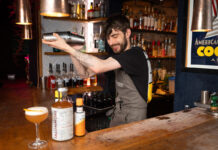The right line-up can offer something for everyone

THERE’S arguably as much variety in the craft beer world as any segment of the drinks industry. Stretching from session IPAs to peanut butter milk stouts, it seems there genuinely is a craft beer out there for everyone.
But as the category matures, there are two main constituencies that operators must appease. How can they encourage new customers to try craft beer? And for the craft beer connoisseurs in their bar, how can they keep their offer fresh and exciting?
Offering a wide range of beers is a good place to start, according to Katy Heppell of Woo Ha Brewing.
She said: “Diversity continues to be important. There is no set style to stick to when the craft beer market is constantly crying out for something new.
“Low-ABV and alcohol-free beers are a growing trend and there are some great low/alcohol-free beers being brewed by Scottish breweries, with more coming out every month.”
For operators looking to tempt more consumers into sampling craft brews, Sarah Stirton of Stewart Brewing reckons lager is a good place to start.
“Lager is the gateway for many people,” she said.
“Pubs have the power to use their lager offerings to introduce people to the craft beer world.
“It’s familiar, comforting people [and they] feel like they know what they are getting. It doesn’t take much convincing to get a lager drinker to take a chance on a craft version.”
Consumers want to drink local and the staff need to know where the beer has come from.
Andy Mee, director of craft beer distributor Firkin Express Wholesale, agreed that there are steps that can be taken to get more people into craft beer.
“Operators need to have information about the beers they have on, tasting notes, style of beer – and the percentage ABV is a must,” he said.
“Staff need to be knowledgeable about the beers in stock – not just about the beer, but also the breweries.
“Consumers want to drink local and the staff need to know where the beer has come from.”
Therefore, staff knowledge “is very important when it comes to persuading the consumer to try something new or different”, according to Andrew Chapman, sales and marketing director of Keith Brewery parent firm Consolidated Craft Breweries.
“This is the responsibility of the brewing industry, to educate the trade where possible on their respective company and beers,” he said. “And the craft beer industry in general.
“If bar staff do not feel comfortable in their knowledge of a product, then they are a lot less likely to engage with the consumer.”
And for bars, it’s an education worth imparting because the industry is “going from strength to strength”, said Stirton of Stewart Brewing.
While stating that IPAs continue to prove popular, Stirton reckons there has also been a surge in sour beers.
“It’s something that peaks people’s interests and appeals to non-traditional beer drinkers,” she said.
“Low-ABV beers are also something we are seeing increased demand for; it represents a move away from heavy drinking and towards an appreciation for the craft behind a beer.”
Craig Steven of Sinclair Breweries, parent firm of Atlas Brewing Company and Orkney Brewery, said that when it comes to catering to craft beer aficionados, as long as the beers on offer “are met with sufficient demand, then everything is in balance”.
Steven added that pairing a craft beer range with certain items off a food menu can also pay dividends.
“Food matching could improve further [and] although a bit of beer and burger porn does capture the interest well on Instagram, it would be good to see more alternative [food and beer] offers,” he said.
“I think with the right education, beer menus could open up this relatively untapped, excuse the pun, potential.”



















